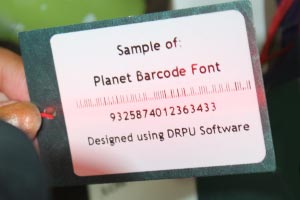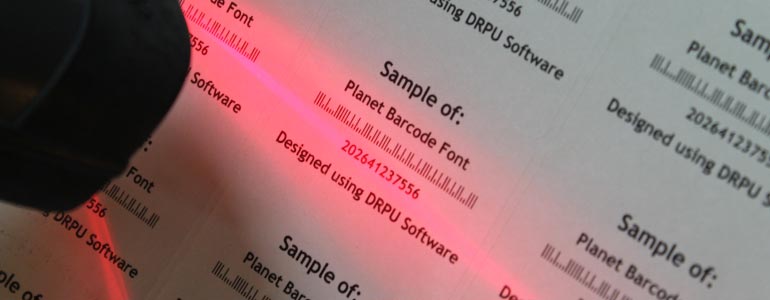Posted By: 👤 Tech Solution
Published On:
Minimum and Maximum Length of a Planet Barcode
The minimum and maximum length of a Planet barcode depends on the length of the ZIP code and DPC being encoded. Each digit of the ZIP code and DPC is represented by a set of bars, with tall bars representing a value of 1 and short bars representing a value of 0. The number of bars required for each digit varies depending on the length of the code.
For ZIP codes that are 5 digits in length, each digit is encoded using a set of 5 bars, resulting in a minimum barcode length of 25 bars. For ZIP codes that are 9 digits in length (including the ZIP+4 code), each digit is encoded using a set of 9 bars, resulting in a minimum barcode length of 45 bars.
The length of the DPC also affects the length of the barcode. DPCs range in length from 1 to 4 digits, and each digit is encoded using a set of 5 bars. This means that the maximum barcode length for a piece of mail is 62 bars, which corresponds to a 5-digit ZIP code and a 4-digit DPC.
It is worth noting that not all pieces of mail require a Planet barcode. First-class mail and other types of mail that are not processed by the USPS sorting system may not require a barcode. Additionally, some types of mail, such as pre-sorted bulk mail, may use a different type of barcode, such as the Intelligent Mail barcode (IMb).
Conclusion: The minimum and maximum length of a Planet barcode depends on the length of the ZIP code and DPC being encoded. For a 5-digit ZIP code and a 1-digit DPC, the minimum barcode length is 30 bars, while for a 9-digit ZIP code and a 4-digit DPC, the maximum barcode length is 62 bars.
Characters That Can be Encoded in a Planet Barcode
-
The Planet barcode can encode only numeric digits from 0 to 9. Each digit of the ZIP code and DPC is represented by a set of bars, with tall bars representing a value of 1 and short bars representing a value of 0. The number of bars required for each digit varies depending on the length of the code.
-
For example, a 5-digit ZIP code requires 5 sets of bars, while a 9-digit ZIP+4 code requires 9 sets of bars. The DPC also varies in length, with a minimum of 1 digit and a maximum of 4 digits. Each digit of the DPC is represented by a set of 5 bars, regardless of its length.
-
In order to encode the ZIP code and DPC in the Planet barcode, the USPS uses a special algorithm called the Delivery Point Validation (DPV) system. This system checks each address to ensure that it is valid and complete, and assigns a unique 11-digit Delivery Point Barcode (DPBC) to each piece of mail.
-
The DPBC includes the ZIP code, the DPC, and a check digit that is calculated based on the other digits in the code. The check digit is used to ensure that the barcode is scanned correctly and that the correct ZIP code and DPC are assigned to each piece of mail.
-
In addition to encoding the ZIP code and DPC, the Planet barcode may also include additional information about the piece of mail, such as the class of mail and any special services requested. This information is typically encoded using a separate barcode, such as the Intelligent Mail barcode (IMb).
Conclusion: The Planet barcode is a simple and effective way to encode the ZIP code and DPC of each piece of mail processed by the USPS. While it can encode only numeric digits, it is a reliable way to ensure that mail is properly sorted and delivered to its intended recipient.
Reading and Decoding Process of a Planet Barcode
The Planet barcode is read and decoded using a barcode scanner or reader, which uses a laser or camera to read the pattern of bars and spaces in the barcode. The scanner converts the pattern of bars and spaces into a series of binary digits (0s and 1s), which are then decoded into the ZIP code and DPC. The decoding process involves several steps:

- First, the scanner reads the height of each bar and space in the barcode and converts it into a series of binary digits. Taller bars represent a value of 1, while shorter bars represent a value of 0. The scanner also measures the width of each bar and space, which is used to determine the timing of the barcode.
- Once the pattern of bars and spaces has been converted into binary digits, the scanner applies a decoding algorithm to extract the ZIP code and DPC. The algorithm uses the position and height of the bars to determine which digits are being represented, and then combines these digits to form the ZIP code and DPC.
- For example, a 5-digit ZIP code is represented by 5 sets of bars, each set encoding one digit. The scanner reads the height and position of each set of bars to determine the value of each digit, and then combines these digits to form the ZIP code.
- Similarly, the DPC is represented by a set of 5 bars for each digit, with the number of sets varying depending on the length of the DPC. The scanner reads the height and position of each set of bars to determine the value of each digit, and then combines these digits to form the DPC.
- In addition to decoding the ZIP code and DPC, the scanner may also be able to read additional information encoded in the barcode, such as the class of mail and any special services requested. This information is typically encoded using a separate barcode, such as the Intelligent Mail barcode (IMb).
Overall, the Planet barcode is a simple and effective way to encode the ZIP code and DPC of each piece of mail processed by the USPS. By using a barcode scanner to read and decode the barcode, the USPS is able to quickly and accurately sort and deliver mail to its intended recipient.
Advantages of Using Planet Barcode
-
01. Improved Speed and Efficiency:
By using a Planet barcode to encode the ZIP code and delivery point code (DPC) of each piece of mail, the USPS can quickly and accurately sort and deliver mail to its intended destination. This reduces the time and resources required to manually sort mail and ensures that mail is delivered in a timely manner.
-
02. Integration With other Barcode Systems
The Planet barcode can be integrated with other barcode systems used by the USPS, such as the Intelligent Mail barcode (IMb), to provide additional information about the mail piece. This can include information about the class of mail, special services requested, and other tracking information.
-
03. Standardized Format:
The Planet barcode is a standardized format used by the USPS, which ensures consistency and compatibility across different mail processing facilities. This makes it easier for the USPS to share information and coordinate mail delivery across different regions.
-
04. Easy to Read:
The Planet barcode is a simple and easy-to-read barcode that can be read by a variety of barcode scanners and readers. This ensures that the barcode can be read and decoded quickly and accurately, regardless of the type of scanner or reader being used.
-
05. Increased Accuracy:
The use of a Planet barcode improves the accuracy of mail sorting and delivery by reducing the likelihood of human error. When mail is sorted manually, there is a greater chance of mistakes being made, which can lead to delays and misdelivery. By using a barcode scanner to read and decode the barcode, the USPS can ensure that each piece of mail is delivered to the correct address.
-
06. Reduced Costs:
The use of a Planet barcode can help to reduce costs for the USPS by improving efficiency and reducing the need for manual sorting. This can help to offset the cost of implementing and maintaining the barcode system..
-
07. Durability:
The Planet barcode is designed to be durable and resistant to damage, which ensures that the barcode remains readable even after it has been exposed to the elements or handled multiple times.
In summary, the Planet barcode offers several advantages when used for sorting and delivering mail by the USPS. These advantages include improved speed and efficiency, increased accuracy, reduced costs, standardized format, integration with other barcode systems, ease of readability, and durability.
Limitations of Using Planet Barcode
Although the Planet barcode offers many advantages for sorting and delivering mail, there are also several limitations that must be considered. These limitations include:
- Limited International Use: The Planet barcode is primarily used by the USPS for mail delivery within the United States. While some countries may use similar barcode systems for mail delivery, the Planet barcode is not widely recognized or accepted outside of the US. This can limit its usefulness for international shipping and delivery.
- Limited Information Storage: The Planet barcode is designed to encode only the ZIP code and delivery point code (DPC) of each piece of mail. This limits the amount of information that can be stored within the barcode. While additional information can be included through the use of other barcode systems, such as the Intelligent Mail barcode (IMb), this requires additional resources and may not be feasible for all types of mail.
- Reliance on Technology: The use of the Planet barcode relies heavily on technology, including barcode scanners and sorting machines. If these technologies fail or are not available, mail may need to be sorted and delivered manually, which can be time-consuming and less accurate.
- Cost of Implementation: Implementing the Planet barcode system can be costly, particularly for smaller businesses or organizations that may not have the resources to invest in new equipment and training. This can limit the ability of some businesses to take advantage of the benefits of barcode technology.
- Complexity: While the Planet barcode is relatively simple compared to other barcode systems, it still requires some level of technical expertise to implement and maintain. This can be a barrier for smaller businesses or organizations that may not have the resources or expertise to manage the system effectively.
- Limited Flexibility: The Planet barcode is designed to be used primarily for sorting and delivering mail, and may not be well-suited for other applications. This can limit its usefulness for businesses or organizations that need a more flexible barcode system.
- Environmental Factors: The readability of the Planet barcode can be affected by environmental factors such as dirt, moisture, and fading. This can make it more difficult to accurately read and decode the barcode, which can lead to delays and misdelivery.
Summary: The limitations of the Planet barcode include limited international use, limited information storage, reliance on technology, cost of implementation, complexity, limited flexibility, and susceptibility to environmental factors. While the barcode offers many benefits for mail sorting and delivery, these limitations must be carefully considered when deciding whether to implement the system.
